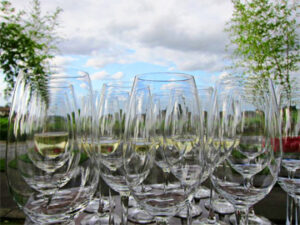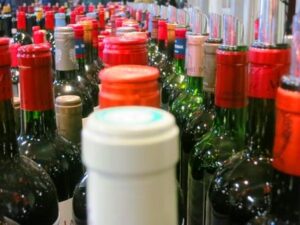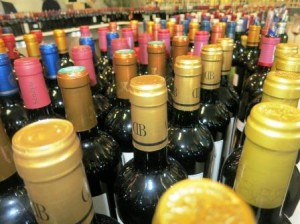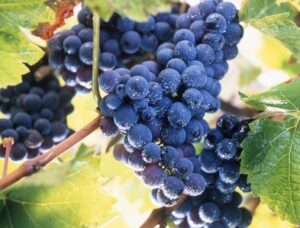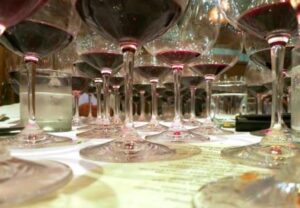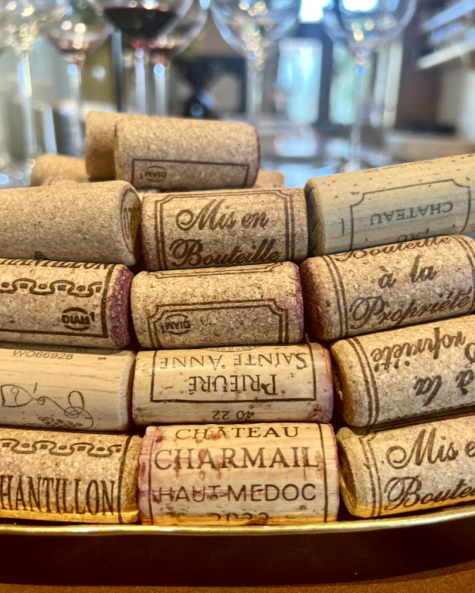
Learn everything about Crus Bourgeois Bordeaux, the best wines, top producers, vineyards, history, and the classification.
If you are seeking to drink the best value priced Cabernet Sauvignon wines in the world, you need to know about Crus Bourgeois. Produced in a myriad of styles, Crus Bourgeois offers well-priced, early drinkability with character and charm. And, because the wines are produced in fairly large quantities, they are easy to find. The Crus Bourgeois of Bordeaux proves you do not need to spend a lot of money to drink well
The Crus Bourgeois Classification continues its round of recent changes since it was first created in 1932. In those days, 444 Medoc chateaux were classified. The Crus Bourgeois Classification continues changing, and as you will read, today, these changes are clearly for the better!
The original 1932 Crus Bourgeois classification was revised several times, in 1966, 1978, 2003, 2008, 2015, 2020 and 2025. The most recent changes shook up the Crus Bourgeois classification, bringing about major changes and an upheaval among some of its most important members as you will read. It is a good thing that the original 1932 classification was not set in stone, unlike the famous 1855 Classification of the Medoc.
For a chateau to be in the Crus Bourgeois Classification, it must come from one of the 8 appellations in the appellation of the Medoc that covers the Left Bank.The communes are: Pauillac, St. Estephe, Margaux, St. Julien, Moulis, Listrac, Haut Medoc and the Medoc.
Today, close to 25% of all the wine produced, bottled, and sold from the Medoc are currently classified as Cru Bourgeois. When added together, the chateaux that make up the Cru Bourgeois Classification own more than 4,100 hectares of vines. The combined production of all the Cru Bourgeois estates comes to more than 29 million bottles of Bordeaux wine per year!
With the 2025 Classification of Cru Bourgeois, a total of 170 estates received classification. This is considerably fewer than the last classification of the vineyards. The classification includes 14 Crus Bourgeois Exceptionnel, 36 Crus Bourgeois Superieur, and 120 Crus Bourgeois.
The decrease in the number of Crus Bourgeois is partly due to a more stringent selection process, as well as estates choosing not to participate in the Classification anymore. Additionally, several vineyards have been purchased and merged into larger or more renowned vineyards, leading to their disappearance. Moving forward, all Crus Bourgeois will be reclassified every five years. The aim of this new standard is to enhance the promotion of the classification for both the chateaux and consumers.
For the 2025 Crus Bourgeois classification, properties will undergo a blind tasting of the previous five vintages. In a nod to the St. Emilion classification, other criteria will also be reviewed. Every producer seeking classification must obtain environmental certifications. Factors such as hospitality, visitor experiences, and promotional efforts will also be assessed.
On the left side of the page, you will find a list of the estates from the current, 2025 Crus Bourgeois Classification. If you follow the links, you can read details about vineyards, wine tasting notes, and more about many of the most important Crus Bourgeois chateaux:
Cru Bourgeois Exceptionnel
la Cardonne
Castera
Laujac
Malescasse
de Malleret
Paloumey
Reysson
du Taillan
Reverdi
dArsac
Mongravey
Paveil de Luze
le Crock
Laffitte Carcasset
Cru Bourgeois Supérieur
la Branne
Escot
Fleur la Mothe
la France Delhomme
Greysac
Haut-Bana
Labadie
Noaillac
Patache dAux
Pierre de Montignac
Poitevin
Preuillac
Saint-Hilaire
les Tuileries
Beaumont
Bel Air Gloria
Clos la Bohème
du Cartillon
Cissac
Dillon
Lamothe Bergeron
Lestage Simon
Liversan
Magnol
Meyre
du Moulin Rouge
Peyrabon
Peyrat-Fourthon
Pontoise Cabarrus
Ramage la Batisse
Biston-Brillette
Lalaudey
la Mouline
la Fortune
de Côme
Tour des Termes
Cru Bourgeois
les Anguilleys
d’Argan
l’Argenteyre
Beauvillage
Begadan
Bégadanet
Bellegrave
Bellevue
de Bensse
Bessan Ségur
le Bourdieu
Bournac
des Cabans
Cangruey
Carcanieux
la Chandellière
Chantemerle
Clément Saint Jean
Côtes de Blaignan
de la Croix
d’Escurac
Gémeillan
la Grange de Bessan
des Granges d’Or
Grivière
Haut Barrail
Haut Canteloup
Haut-Maurac
Haut Queyran
Lacombe Noaillac
Ladignac
Lalande d’Auvion
Lassus
les Lattes
Leboscq
Lestruelle
Lousteauneuf
Maison Blanche
Mareil
Mazails
Méric
Moulin de Bel Air
Moulin de Canhaut
Moulin de l’Abbaye
Moulin de Taffard
les Mourlanes
Nouret
de Panigon
Pey de Pont
La Pirouette
Plagnac
Pontet Barrail
Pontey
Ramafort
la Ribaud
Ricaudet
la Roque de By
Roquegrave
Rousseau de Sipian
Saint-Aubin
Saint Bonnet
Saint-Christophe
le Temple
Tour Castillon
Tour Prignac
Tour Saint Vincent
des Tourelles
les Tresquots
Troussas
la Valière Vieux
Landon
le Vieux Fort
Vieux Robin
le Vieux Serestin
d’Arcins
d’Aurilhac
Barateau
Barreyres
Bibian
le Bourdieu Vertheuil
de Braude
de Cartujac
Corconnac
Croix du Trale
Dasvin Bel Air
Devise d’Ardilley
la Fon du Berger
Grand Clapeau Olivier
Grandis
Haut Beyzac
Haut-Madrac
Lacour Jacquet
Martin
le Monteil d’Arsac
Moulin de Blanchon
Moulin des Moines
Prieuré de Beyzac
Puy Castera
du Raux
Rollin
Saint Ahon
Sénilhac
Tourteran
Victoria
Vieux Landat
de Villambis
Capdet
Donissan
Lafon
Lalande
Liouner
Sémeillan Mazeau
Guitignan
Pomeys
Plantey
la Commanderie
Coutelin Merville
German Marbuzet
Picard
Tour Saint-Fort
Cru Bourgeois Bordeaux Wine Today
For wine lovers seeking well-priced, Left Bank Bordeaux wine that provides style, character, and quality for a fair price, it’s important to know the Cru Bourgeois classified wines. Being Left Bank wines, most Cru Bourgeois are dominated by Cabernet Sauvignon. However, over the past few decades, many estates have added more Merlot to their blend, in an effort to soften the wines.
These wines deliver value, and very good wine drinking if you know which wines to look for. At their best, there are Cru Bourgeois estates that compete with much more expensive Bordeaux chateaux. In fact, in some cases, compete might not be a strong enough term. At their best, the top Cru Bourgeois wines can be better than some of the more famous, and more expensive 1855 Classified Growths!
Cru Bourgeois wines, ageability and drinkability…
Today there are also several Cru Bourgeois estates making quality Bordeaux wine that can age and develop complexities that experienced connoisseurs love to find in mature wines. And it is important to note that with climate change, you find more ripeness in the wines, than you did in the past.
But, many Cru Bourgeois classed wines can be rustic, or quite green and herbal, especially if the vintage is not a ripe year. But, with climate change, which has had an affect on the cooler terroirs, where many Cru Bourgeois are located, today’s warmer climate has helped the grapes achieve better levels of ripeness.
It is important to note that while the wines can age, and develop complexities and secondary nuances, most Cru Bourgeois can be enjoyed much earlier in life than the more expensive Left Bank wines, which is positive in today’s world.
While the wines reach maturity earlier than their more expensive cousins in the Medoc, they will not age as long in the majority of cases. Most of these wines are going to be at their best between 5 to 15 years after the vintage. Of course, as we mentioned, there are wines that can age for even longer periods of time. Moderate years will need to be consumed earlier.
The Best Vintages of Cru Bourgeois Bordeaux are: 2023, 2022, 2021, 2020, 2019, 2018, 2017, 2016, 2015, 2014, 2012, 2010, 2009, 2006, 2005 and 2000. Though, it is important to note that the 2022 Bordeaux vintage set a new standard for the Cru Bourgeois with more wines scoring 90 Pts and above and above, than at any time in history. Climate change has been quite positive for these estates. To read about vintages from the Cru Bourgeois vineyards and all the other Bordeaux appellations; Bordeaux Vintage Charts 1959 Through Today
Generally speaking, the top vintages for the Cru Bourgeois wines mirror the Left Bank as you can see from the vintages list above. Cru Bourgeois wines are more vintage dependent than the better terroirs in the Medoc. This is especially true in difficult vintages. In those years, Cru Bourgeois wines that require owners with the ability, knowledge and financial ability to get the most from their vineyard. When you discover those wines, you can be in for a treat that won’t break the bank! But for financial reasons, that does not always happen, as the wines are usually low in price to start with.
Cru Bourgeois wines tend to come from vineyards dominated by Cabernet Sauvignon, which are planted in the better gravel soils, located close to the major appellations. For many vineyards, Merlot is just as important as Cabernet Sauvignon in the blend for a large percentage of these wines.
The Top Ten Facts You Need To Know About Crus Bourgeois Bordeaux Wines
#1 Over 25% of all wines from the Medoc are Crus Bourgeois classified Bordeaux wines.
#2 The first classification of Crus Bourgeois wines took place in 1932.
#3 In the first Crus Bourgeois classification in 1932, 444 chateaus was classified.
#4 Today, there are only 170 Crus Bourgeois classified estates, the smallest number of properties since the classification was first introduced.
#5 The Medoc has more Crus Bourgeois classified wines than any other Bordeaux appellation.
#6 The classification of Crus Bourgeois Bordeaux wines is the only classification that is renewed every 5 years.
#7 Over 2,500,000 cases of Bordeaux wine are produced from all the Cru Bourgeois estates per year!
#8 Merlot is just as important to the blends as Cabernet Sauvignon for many Cru Bourgeois Bordeaux wines.
#9 The Medoc and Haut Medoc combined is where you find the majority of Cru Bourgeois Bordeaux wines.
#10 The classification of Cru Bourgeois Bordeaux wines is the only classification that was ever based solely on the results of blind tastings.
Cru Bourgeois vineyards and appellations
It is instructive to get a good look and an understanding of where the Crus Bourgeois chateaux are situated in the Left Bank in the current Classification. Previous classifications were quite different with a much larger concentration of vineyards in St. Estephe for example. There are several reasons for all the changes. Consolidation is a big factor. Over the years, numerous vineyards have been purchased by neighboring properties, and integrated into other vineyards, so that they no longer exist. Plus, you have estates that for various, personal reasons do not want to be classified.
Cru Bourgeois Wine and Food Pairing Cru Bourgeois Bordeaux wines are quite easy to pair with food. Lamb, beef, veal, pork, stews, braised dishes, roasts, grilled meat or game, and earthy dishes with mushrooms are perfect.
Hard and soft cheese is also great for wine and food matches. Plus, because Cru Bourgeois Bordeaux wines do not normally need much, if any aging, you can buy a bottle today, and open it tonight if you wish!
History of Cru Bourgeois Classifications
Unofficially, a type of Crus Bourgeois Classification has been in existence since at least 1850, when Cocks and Feret created three categories for the wines, Cru Bourgeois Classification, Cru Bourgeois Superieur, Bon Cru Bourgeois and Crus Bourgeois. However, when the official 1855 Classification of the Medoc took place, several of those chateaux felt slighted for not being included in what was to become a historic document. This gave birth to what we know of as the Classification of Cru Bourgeois wines.
When the 1932 Crus Bourgeois Classification was initially created, a massive array of producers were included, 444 in total! 99 were classed as Cru Bourgeois Superieur and 18 were granted the title of Cru Bourgeois Exceptionnel.
However, unlike the 1855 classification of the Medoc, the Cru Bourgeois classification was never certified by the French Government. Eventually, that lack of certification led to a continuing reclassification of the Cru Bourgeois chateau and vineyards. It took until 1962 before an official syndicate of Crus Bourgeois wines was even established.
Over the years, due to the constantly changing Cru Bourgeois Classifications, some unsuccessful applicants sued, saying the selection procedure was biased, with conflicts of interest. That led to lawsuits being filed. Classified estate’s sued because chateaux that were not from the Medoc began using the term Cru Bourgeois, as did wineries that were not Cru Bourgeois. The court ruled in the applicants favor.
Crus Bourgeois, the birth of the modern era.
In 2002, a tasting took place and wines were submitted from all estates wishing to be classed as Cru Bourgeois. The wines to be tasted were from a 5 year period, covering 1994 to 1999. The results produce three levels of Crus Bourgeois wines to be classified; Cru Bourgeois, Crus Bourgeois Superieur and Crus Bourgeois Exceptionnel. The new rules stated that this new classification would be revised every ten years and was to be certified by the French Government.
In 2003, the results were announced with 247 chateaux earning the Crus Bourgeois Classification. There were multiple reasons the number of classified wines declined in the new classification.
First, several vineyards were purchased by larger estates and merged out of existence. Also, some wines did not apply to be classified, for example, Chateau Sociando Mallet.
The classification process also found 77 wines that were deemed not worthy of the classification based on blind tastings. Those estates were demoted and removed from the classification.
One property displayed their sense of humor their indignity over being dropped from the Crus Bourgeois Classification. Chateau Lafon, owned by Remy Fauchey changed the name of their estate to Chateau L’Inclassable, which is translated to Uncategorized, making a strong comment on their lack of classified status.
However, like the ever-changing classification in St. Emilion, there were chateau that were not happy with the results. Some sued, while others simply removed the Crus Bourgeois classification off their wine labels. After the lawsuits were adjudicated, the judges ruled that the classification was not valid.
The court found that there were conflicts of interest, and the blind tasting panel was not considered to be competent. From that point forward, events rapidly changed into what we have today with the Crus Bourgeois classification.
The Alliance des Crus Bourgeois du Medoc came up with a new Crus Bourgeois Classification system in 2008, that would be continually updated, making it the most current, living classification for wines, as it would be updated every year. Along with yearly reviews, the Alliance des Crus Bourgeois discontinued the previous levels in their classification.
The terms Crus Bourgeois Superieur and Crus Bourgeois Exceptionnel were stopped. Another important factor within the new system of classifying the wines is that today, it is the specific wine that is classified, not the chateau or vineyard. That is a big part of the reason the classification is renewed every year.
Due to that decision, numerous estates that were previously part of the Crus Bourgeois classification declined to participate in the future classifications saying; “That the updated system lacks the prestige and charm of the original Crus Bourgeois classification, therefore, they resign.”
Potensac, Haut Marbuzet, Phelan Segur, Poujeaux, Sociando Mallet, and other chateaux that were undeniably the top Crus Bourgeois producers are still no longer part of the classification of Crus Bourgeois.
Their logic was perfectly reasonable. Why should they bear the same level of classification as other estates that made wines under their level of quality that also sold for half the price or even less? So, what happened is that several of the top estates that were formally classified as Crus Bourgeois refused to participate in the new classification.
Of course they were right about the loss of prestige. The new classification did not award differing levels of quality. Perforce, chateaux that had earned the level of Cru Bourgeois Exceptionnel were not separated from the other producers, who made lesser quality wine.
This new system led to the refusal of the top chateaux to participate with The Alliance des Crus Bourgeois. So far, they have not rejoined the Crus Bourgeois.
Instead, they created their own competing organization, Les Exceptionnels. All of the former classified Cru Bourgeois Exceptionnel joined this new group, with the exception of two chateaux; Chateau Haut-Marbuzet, who no longer wants to be part of either classification, and Chateau Phelan Segur.
The decision of Chateau Phelan Segur was understandable, because the owner of Phelan Segur at the time, Thierry Gardinier, was the director of the Alliance Cru Bourgeois, which would have made that a clear conflict of interest. It is interesting to note, that today, under new ownership, Phelan Segur is not a member of the Alliance Cru Bourgeois.
Cru Bourgeois Classification Today The 2010 Crus Bourgeois Classification was released in September 2012. The Alliance des Crus Bourgeois made significant changes in those results. As you now know, for the first time, all Crus Bourgeois chateaux were equal in ranking.
The previous classification of Cru Bourgeois Exceptionnel was no longer being used. The new system had all chateaux and wines considered equals and instead of a multi-tiered classification. The marketplace did not care for the new classification, let alone understand it. Neither did several of the producers.
How was the removal of the different levels of classification perceived by the Bordeaux Cru Bourgeois producers? The estates that held the ranking of Cru Bourgeois Exceptionnel were furious to lose their position of status. Of course, everyone else was thrilled to be thought of as being at the same level of class as the top estates.
Did consumers care? In America, no, it didn’t matter. The only true classification that works in America, and frankly with most of the wine buying world is the marketplace.
How many chateaux are in the Cru Bourgeois Classification?
The number of Cru Bourgeois classified estates continues evolving. For the 2009 classification, 246 estates were included in the Cru Bourgeois Classification. That quickly grew to 260 chateaux with the 2010 Classification. For the 2011 vintage, 256 wineries were included.
With the 2012 Cru Bourgeois Classification, The Alliance des Crus Bourgeois du Medoc awarded Cru Bourgeois status to 267 chateaux.
The continued growth among the Cru Bourgeois producers took a step back with the difficult 2013 vintage, as only 251 estates were classified. In 2020, 250 chateaux were classified.
Chateaux included in the Cru Bourgeois are spread among the different appellations with the majority of estates coming from the Medoc, followed by the Haut Medoc, Medoc and then St. Estephe, Moulis, Listrac, Margaux, and Pauillac. There were no Cru Bourgeois chateau from the Saint Julien appellation included in the classification as 2015.
The forward-thinking Frederic de Luze, the influential, president of the Alliance Crus Bourgeois and the owner of Chateau Paveil de Luze in the Margaux appellation really sparked much of the innovation and modernization of the Cru Bourgeois classification before he passed away.
Frederic de Luze was replaced in 2016 by Olivier Cuvelier, whose family owns Chateau Le Crock in Saint Estephe, as well as Chateau Leoville Poyferre in Saint Julien. Cuvelier was replaced by Franck Bijon, Managing Director of Larose Vineyards.
In late 2015, things changed again for the Cru Bourgeois classification, and in my opinion, for the better. Starting with the 2018 vintage, which was released in 2020, chateaux were classified into two different levels of quality, Cru Bourgeois and Cru Bourgeois Superieur.
Plus, instead of reclassifying their wines every year, the new classification would remain in place for 5 years. This was a positive step for the new “Classement des Crus Bourgeois du Medoc” as it gained favor with the wine-buying public. Another development for the better was a change in the rules for earning classification status.
Blind tasting’s which takes place shortly after bottling, about 18 months after the vintage will only be used to measure 50% of the score. Things like the terroir, the chateau, and promotional efforts could also be considered.
Bureau Veritas, an independent entity, was chosen to evaluate the chateaux, looking at everything from their grounds, vineyards and cellars. The agency also oversees the blind tastings submitted to a jury of Bordeaux professionals.
Early results show that Cru Bourgeois Classified estates are able to sell their wine for slightly more than wines with only their appellation listed on the label. All of that factored into the vote taken in 2015, supporting the changes for the new Cru Bourgeois classification of 2020.
Updates to the current Cru Bourgeois Classification…
The new Cru Bourgeois classification of 2020 marked a return for the different levels of classification. The best chateau will be classed as Cru Bourgeois Superieur, Cru Bourgeois Exceptionnel and Cru Bourgeois.
Even better, from 2020 forward the classification will stand for a 5-year period of time. This should help raise the level of awareness for the Cru Bourgeois estates.
The level of classification will be determined by 4 different criteria, with each criteria having a different weight. Most importantly, each estate will present the 5 most recent vintages of their wine for a blind tasting.
Chateaux will also be graded on their viticultural practices and environmental awareness. The vinification and barrel aging regimen will be looked at with new a critical level of awareness.
Chateau that for example are able to vinify on a parcel by parcel basis is going to be rated higher. Lastly, an estates promotional activity, which includes receiving visitors, marketing and distribution of their wine in France and more importantly, in the export market is also going to be a factor that counts to determine an estates level in the new Cru Bourgeois classification of 2020.
This is a constructive improvement to the cumbersome, and difficult-to-understand classification system. In Bordeaux, classification is always an issue. Levels of status in classifications or certifications really do matter.
Plus, having personal experience tasting a lot of Cru Bourgeois wines, clearly, there are chateaux that produce much better wine than the wine produced by their peers.
To add a sense of quality to the list, and to hopefully lure the top estates who refused to participate in the classification because of their loss of status in the previous classification, it’s good to see different tiers of quality once again represented in the classification.
There has been another additional positive development with the new Cru Bourgeois Alliance. Wine labels from members now feature an authentication sticker that showcases the Cru Bourgeois logo. This clearly visible sticker lets consumers easily know that the wine is a classified Cru Bourgeois Bordeaux wine.
More importantly, joining the modern age well ahead of many more expensive Bordeaux wines, from the 2010 vintage forward, all Cru Bourgeois wine labels feature a QR code, (Bar Code) on their back label. The machine-readable code can provide some great background on the wines, the estate, the blend, etc. The QR code can be easily read using almost any smartphone.
Frankly, there has never been a better time in history to be a lover of Cru Bourgeois Bordeaux wine. Today, with what the estates know about their vineyards, and the drive to produce the best level of wine possible, along with a new era of climate change, the wines have never been better! And they continue to remain affordable alternatives to the more expensive Classified Growths in the Medoc. If you do not know how good many of the Cru Bourgeois wines are, it is time you tasted some.

